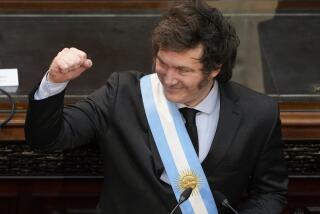Argentina and Brazil OK Trade Integration Pact : Historic Accord May Pave Way for Formation of a Regional Common Market
- Share via
BUENOS AIRES — Laying aside two centuries of rivalry, Argentina and Brazil formally agreed Tuesday to a program of economic integration that could lay the foundation for a long-sought Latin American common market.
“This is a day of fiesta for Latin America,” said Uruguayan President Julio Sanguinetti, who joined Argentine President Raul Alfonsin and Brazil’s visiting President Jose Sarney at a working lunch to express his support for the program.
Alfonsin and Sarney, who are both reformers and leaders of middle-of-the-road civilian governments, signed 11 protocols that would more than double trade between the two traditional competitors to about $3 billion by 1990.
The agreements grant mutual preferences in purchases of industrial and agricultural goods over goods from third countries and stress greater integration of energy, communications and transport.
‘Will Bury Competition’
Implementation of at least one of the protocols, dealing with the supply of natural gas from fields in Argentina’s Patagonia to southern Brazil, would also involve Uruguay, which is sandwiched between its giant neighbors.
“We will bury competition with the fraternal people of Brazil,” said Alfonsin, applauding Sarney’s visit.
“Never have our two countries been closer than today,” Sarney said. “Never have so many conditions guided our history toward ever-greater integration.”
Sarney stressed that the accords were made possible by the “happy coincidence that both countries restored democracy at almost the same time.” For the past year, Argentina and Brazil have been ruled by democratic governments for the first time since 1963.
Addressing a joint session of the Argentine Congress on Tuesday, Sarney vowed further efforts to promote integration: “This is the first step of a difficult race. We are going to walk, we are going to fly, we are going to sail, we are going to grow together,” he said.
Brazil and Argentina, South America’s two largest economies, have a combined gross national product of $300 billion and a population of 165 million. If their economic alliance prospers, it could grow to include smaller neighboring countries such as Uruguay, Paraguay and Bolivia.
At their last summit meeting, in Uruguay in 1967, Latin American presidents and U.S. President Lyndon B. Johnson agreed to create a Western European-style Latin American common market by 1985. Progress languished in a period of widespread military rule in the 1970s, but the dream never died.
The specific agreements signed Tuesday are designed to favor local products over foreign competition as a means of expanding trade and reducing the outflow of hard currencies. Together, the two countries have a foreign debt of more than $150 billion and share a conviction that solving the debt problem is a political issue that must involve First World governments as well as private creditors.
Hydroelectric Project
One of the protocols abolishes customs duties on up to $2 billion worth of imports of capital goods between the two countries by 1990. Another pledges joint financing and construction of a $2-billion hydroelectric project on the Uruguay River. The agreements also call for Brazil and Argentina to prospect jointly for oil and gas and to consider construction of a $2-billion gas pipeline from southern Argentina to Brazil.
Brazil also agreed to buy 1.375 million tons of Argentine wheat--the amount would rise to 2 million tons in 1991--in exchange for Argentine purchases of Brazilian iron ore.
The integration plan has triggered scattered opposition in both countries. There have been objections from Brazilian farmers, whose agriculture is not as efficient as Argentina’s. Argentine industrialists, accustomed to operating behind high tariff walls, are fearful of Brazil’s more efficient and dynamic industry.
More to Read
Sign up for Essential California
The most important California stories and recommendations in your inbox every morning.
You may occasionally receive promotional content from the Los Angeles Times.










